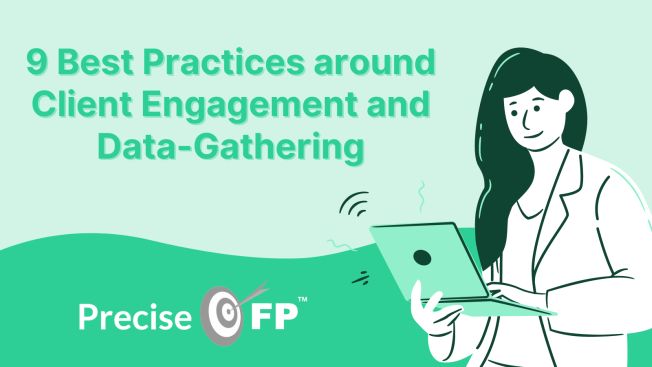I’d like to talk to you today about one of the most important, yet probably one of the most neglected, areas of financial planning: data gathering.
Let’s face it, data gathering isn’t exactly one of the more glamorous aspects of financial planning. Your clients don’t like to do it, and you don’t like the work of processing the data once they are done providing it to you. But if the CFP® Board thought it important enough to list data-gathering in one of the 7 steps to financial planning, it’s probably worth seeing if you could make the experience better for your clients and your staff. After all, if the financial planning process is a burden, you are likely going to experience pushback and maybe even abandonment. And since a disengaged client is far less sticky than an engaged client, learning more about the secret to making a better glue is just good business sense.
To help you determine whether your processes and technology are up to snuff, here are my 9 best practices around client engagement and data gathering:
- Let clients choose their device. It’s no secret, we all have our preferred device. Whether it’s a smart phone, a tablet, or a trusty computer, we want to use the device we want, when we want it, and where we want it. Your data-gathering solution should be responsive enough to adjust to fit the screen size of your client’s device and for your client to easily navigate to get the job done. A little hint here: spreadsheets, word docs and PDF’s don’t play nice with just any device.
- Prefill, Prefill, Prefill. If you already have some of your client’s data in your CRM or financial planning tool, you should be using that data to prefill any client engagement piece that you are using. If they filled out a financial profile questionnaire last year, prefill this year’s with the same data so that it then becomes an exercise of updating, rather than starting from scratch. Never send blank engagements. It’s just bad manners.
- Be specific. You should offer a different experience for every client type you serve. Maybe that’s eliminating fields or entire sections that you know don’t apply to your client. Why present a recent college graduate with a “Household” section when you know she’s single and lives on her own? Similarly, a retired couple whose children have long since graduated from college shouldn’t be presented with a “College Planning” section for their kids’ education. It may seem trivial, but the more you can make your client feel like the experience was tailored to their needs, the more they will appreciate your efforts and the more likely they will be willing to put forth an effort in providing you the data you need.
- Avoid the “Doctor’s Office Experience”. I recently went to a doctor’s office and was presented with three different clipboards, each having a questionnaire to fill out. If having to actually put pen to paper (who does that?!) wasn’t bad enough, I had to fill in my name and address at the top of each form – yes, the same name and address THREE TIMES! If I ran a doctor’s office, I’d at least hand my patient a tablet with their data already pre-filled and the software would require minimal navigation to get the job done fast. I want to provide my clients with an amazon.com experience, not a doctor’s office experience. Don’t you?
- Make sure your tools are sharp and your toolbox complete. In order to effectively engage your clients, the tools you use should be state of the art in allowing you to craft custom engagements, right down to the client level, if you so choose. If your tools don’t allow you to easily do that, you’ll never get to the level of client engagement that I am talking about in this article. Remember, we advisors are not only competing against ourselves, we’re competing against an increasing army of robo advisors, each one increasingly more sophisticated than the previous. Your tools need to allow you to create an experience that is unique to your firm. And you should be able to implement workflows that use your custom engagement templates that you can then deploy company-wide.
- Provide a one-stop-shop for all client engagement. Think you’re the only one with fintech fatigue? Finding it hard to manage all those software applications you use? I bet your client is too. Having to log into different places to provide financial profile data, risk assessment testing, e-signed documents, and everything in between, is a lot to ask of your client. Not to mention the fact that each application has its own navigation characteristics that need to be learned. To every extent possible, your clients should be able to have one place to log into and one interface to learn, so that the process is easy and confusion is minimized.
- Don’t treat your staff like bots. If your clients don’t enjoy filling out paper forms or excel spreadsheets, then why do you think that your staff likes trying to decipher chicken scratches and inconsistent data from clients and then manually entering that data into your CRM and financial planning tools? Even a bot has it better than that since it gets data in a predictable and oftentimes “scrubbed” state. Your staff is more important than a bot. Show them their value by getting them out of the pain of data gathering and data entry.
- Keep the party going all year long. Did you know that you’re supposed to engage with your clients (in a meaningful way) 12 to 18 times a year to stay relevant and keep your clients as, well… clients? That’s a lot of client touches throughout the year. Traditional methods of calling and meeting face-to-face are not only time consuming, but they have also become passé in this new era of client engagement. Your client engagement system should reflect the way clients want to be engaged and should become an integral part of your continuous client engagement efforts throughout the year. That same system that engages clients for updates to their financial profile should also engage clients on topics such as end-of-year tax planning, beginning-of-year goal setting, or even budgeting for an upcoming summer vacation. Your clients rely on you to help them navigate the saving and spending waters of their financial journey. Using the same client engagement system allows clients to stay engaged in a targeted fashion, and with minimal hassels.
- Security matters. Do you think that Google Forms, Excel spreadsheets and PDFs provide you with the level of security you need to protect your clients’ “Personally Identifiable Information” (PII) such as SSNs and other sensitive information? Think again. And, if you think that clients aren’t wise to the inadequacies of such potential means of engagement, you’d be doubly wrong. Suffice to say that your engagement system needs to put security first. I realize I listed this one as the last item in my list, but it truly is the most important. If you can’t securely capture information from your clients, the whole engagement and data gathering exercise is futile. Your clients will judge you on the level of security that you provide them. Make sure that it’s a favorable judgment.
I’ve been working in the financial services industry for nearly 20 years now. In the last 2 years, I believe we have seen more changes occur than in my first 18. The recent pandemic has certainly played a role as advisors have scrambled to find new ways to engage clients who have become accustomed to not having face-to-face meetings. But even before that, robo solutions, combined with our amazon.com way of life, have forced advisors to not only adapt and offer tailored client engagement solutions that meet client expectations, but also allow advisory firms to gain much-needed efficiencies at the firm level in order to stay competitive. I hope that these best practices that I have shared with you will cause you to reflect on how you can improve the experience for your clients and your staff as well as have a meaningful impact on your bottom line.
Don Whalen, CFP®, CEO




